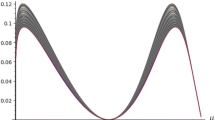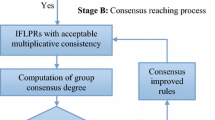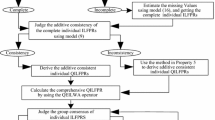Abstract
Deriving the priority vectors of the alternatives from preference relations is an interesting research topic for group decision making with preference information. This paper uses an example to show that the ranking or the optimal alternative could not always be derived from the existing additively consistent intuitionistic fuzzy preference relations. Thus, we provide novel additively consistent intuitionistic fuzzy preference relations and characterize them with Tanino’s normalized (T-normalized) intuitionistic fuzzy priority vectors. Then, we propose some methods to check and achieve the T-normalization, acceptably additive consistency and consensus of the intuitionistic fuzzy preference relations in group decision making using the local, individual and optimal collective intuitionistic fuzzy priority vectors, respectively. We also give some examples to show how the proposed models work and make comparisons with the existing methods to demonstrate the advantages of the proposed methods.



Similar content being viewed by others
References
Atanassov K (1986) Intuitionistic fuzzy set. Fuzzy Sets and Systems 20:87–96
Alias F, Abdullah L, Gou X, Liao H, Herrera-Viedma E (2019) Consistent fuzzy preference relation with geometric Bonferroni mean: a fused preference method for assessing the quality of life. Applied Intelligence 49:2672–2683
Behret H (2014) Group decision making with intuitionistic fuzzy preference relations. Knowl-Based Syst 70:33–43
Chen S M, Tan J M (1994) Handling multicriteria fuzzy decision-making problems based on vague set theory. Fuzzy Sets and Systems 67:163–172
Capuano N, Chiclana F, Herrera-Viedma E, Fujita H, Loia V (2018) Fuzzy group decision making with incomplete information guided by docial influence. IEEE Transactions on Fuzzy Systems 26:1704–1718
Capuano N, Chiclana F, Herrera-Viedma E, Fujita H, Loia V (2019) Fuzzy group decision making for influence-aware recommendations. Computers in Human Behavior 101:371–379
Chiclana F, Herrera F, Herrera-Viedma E (1998) Integrating three representation models in fuzzy multipurpose decision making based on fuzzy preference relations. Fuzzy Sets and Systems 97:33–48
Chiclana F, Herrera-Viedma E, Alonso S, Herrera F (2009) Cardinal consistency of reciprocal preference relations: a characterization of multiplicative transitivity. IEEE Transactions on Fuzzy Systems 17:14–23
Chu J, Liu X, Wang Y, Chin K (2016) A group decision making model considering both the additive consistency and group consensus of intuitionistic fuzzy preference relations. Computers & Industrial Engineering 101:227–242
Deschrijver G, Kerre E E (2003) On the relationship between some extensions of fuzzy set theory. Fuzzy Sets and Systems 133:227–235
Dong Y, Zha Q, Zhang H, Kou G, Fujita H, Chiclana F, Herrera-Viedma E (2018) Consensus reaching in social network group decision making: Research paradigms and challenges Knowledge-Based Systems 162: 3–13
Fedrizzi M, Brunelli M (2009) On the normalisation of a priority vector associated with a reciprocal relation. International Journal of General Systems 38:579–586
Gong Z, Li L, Forrest J, Zhao Y (2011) The optimal priority models of the intuitionistic fuzzy preference relation and their application in selecting industries with higher meteorological sensitivity. Expert Systems with Applications 38:4394–4402
Gau W L, Buehrer D J (1993) Vague sets. IEEE Transactions on Systems Man and Cybernetics 23:610–614
Guo K H (2014) Amount of information and attitudinal based method for ranking Atanassov’s intuitionistic fuzzy values. IEEE Transactions on Fuzzy Systems 22:177–188
Hong D H, Choi C H (2000) Multicriteria fuzzy decision-making problems based on vague set theory. Fuzzy Sets and Systems 114:103–113
Herrera-Viedma E, Herrera F, Chiclana F, Luque M (2004) Some issues on consistency of fuzzy preference relations. European Journal of Operational Research 154:98–109
Liao H C, Xu Z S (2014) Priorities of intuitionistic fuzzy preference relation based on multiplicative consistency. IEEE Transactions on Fuzzy Systems 22:1669–1681
Liao H C, Xu Z S, Zeng X, Xu D (2016) An enhanced consensus reaching process in group decision making with intuitionistic fuzzy preference relations. Information Sciences 329:274–286
Lin M, Zhan Q, Xu Z S, Chen R (2018) Group decision-making model with hesitant multiplicative preference relations based on regression method and feedback mechanism. IEEE Access 6:61130–31150
Lin M, Zhan Q, Xu Z S, Chen R (2018) Group decision making with probabilistic hesitant multiplicative preference relations based on consistency and consensus. IEEE Access 6:63329–63344
Li C, Dong Y, Xu Y, Chiclana F, Herrera-Viedma E, Herrera F (2019) An overview on managing additive consistency of reciprocal preference relations for consistency-driven decisionmaking and fusion:Taxonomyand future directions. Information Fusion 52:143–156
Luo S, Zhang H, Wang J, Li L (2019) Group decision-making approach for evaluating the sustainability of constructed wetlands with probabilistic linguistic preference relations. Journal of the Operational Research Society 70:2039–2055
Ma Z M, Xu ZS, Yang W (2020) Approach to the consistency and consensus of Pythagorean fuzzy preference relations based on their partial orders in group decision making. Journal of Industrial & Management Optimization. https://doi.org/10.3934/jimo.2020086
Ma Z M, Xu Z S (2018) Hyperbolic scales involving appetites-based intuitionistic multiplicative preference relations for group decision making. Information Sciences 451-452:310–325
Ma J, Fan Z P, Jiang Y P, Mao J Y, Ma L (2006) A method for repairing the inconsistency of fuzzy preference relations. Fuzzy Sets and Systems 157:20–33
Meng F, An Q, Tan C, Chen X (2017) An approach for group fecision making with interval fuzzy preference relations based on additive consistency and consensus analysis. IEEE Transactions on Systems Man, and Cybernetics 47:2069–2082
Meng F, Tang J, Fujita H (2019) Linguistic intuitionistic fuzzy preference relations and their application to multi-criteria decision making. Information Fusion 46:77–90
Meng F, Tang J, Xu Z (2019) Deriving priority weights from intuitionistic fuzzy multiplicative preference relations. International Journal of Intelligent Systems 34:2937–2969
Liu X, Pan Y, Xu Y, Yu S (2012) Least square completion and inconsistency repair methods for additively consistent fuzzy preference relations. Fuzzy Sets and Systems 198:1–19
Orlovsky S A (1978) Decision-making with a fuzzy preference relation. Fuzzy Sets and Systems 1:155–167
Saaty T L (1980) The Analytic Hierarchy Process, McGraw-Hill, New York NY
Tanino T (1984) Fuzzy preference orderings in group decision making. Fuzzy Sets and Systems 12:117–131
Urena R, Chiclana F, Fujita H, Herrera-Viedma E (2015) Confidence-consistency driven group decision making approach with incomplete reciprocal intuitionistic preference relations. Knowledge-Based Systems 89:86–96
Wan S, Xu G, Dong J (2016) A novel method for group decision making with interval-valued Atanassov intuitionistic fuzzy preference relations. Information Sciences 372:53–71
Wang Z J, Li K W (2012) Goal programming approaches to deriving interval weights based on interval fuzzy preference relations. Information Sciences 193:180–198
Wang Z J (2013) Derivation of intuitionistic fuzzy weights based on intuitionistic fuzzy preference relations. Applied Mathematical Modelling 37:6377–6388
Wang Z J (2014) A note on “Incomplete interval fuzzy preference relations and their applications”. Computers & Industrial Engineering 77:65–69
Wang Z J, Wang Y, Li K W (2016) An acceptable consistency-based framework for group decision making with intuitionistic preference relations. Group Decision and Negotiation 25:181–202
Wu J, Chiclana F, Liao H (2018) Isomorphic multiplicative transitivity for intuitionistic and interval-valued fuzzy preference relations and its application in deriving their priority vectors. IEEE Transactions on Fuzzy Systems 26:193–202
Wu J, Sun Q, Fujita H, Chiclana F (2019) An attitudinal consensus degree to control the feedback mechanism in group decision making with different adjustment cost. Knowledge-Based Systems 164:265–273
Xu Y, Li K W, Wang H (2013) Distance-based consensus models for fuzzy and multiplicative preference relations. Information Sciences 253:56–73
Xu Y, Li K, Wang H (2014) Incomplete interval fuzzy preference relations and their applications. Computers & Industrial Engineering 67:93–103
Xu Y, Liu X, Wang H (2018) The additive consistency measure of fuzzy reciprocal preference relations. International Journal of Machine Learning & Cybernetics 9:1141–1152
Xu Y, Herrera F (2019) Visualizingandrectifyingdifferentinconsistenciesforfuzzy reciprocalpreferencerelations. Fuzzy Sets and Systems 362:85–109
Xu Z S (2005) Deviation measures of linguistic preference relations in group decision making. Omega 33:249–254
Xu Z S (2007) Intuitionistic preference relations and their application in group decision making. Information Sciences 177:2363–2379
Xu Z S, Cai X Q, Szmidt E (2011) Algorithms for estimating missing elements of incomplete intuitionistic preference relations. International Journal of Intelligent Systems 26:787–813
Yang Y, Wang X X, Xu Z S (2019) The multiplicative consistency threshold of intuitionistic fuzzy preference relation. Information Sciences 477:349–368
Zhang G, Dong Y, Xu Y (2012) Linear optimization modeling of consistency issues in group decision making based on fuzzy preference relations. Expert Syst Appl 39:2415–2420
Zhang H (2016) Group decision making based on multiplicative consistent reciprocal preference relations. Fuzzy Sets and Systems 282:31–46
Zhang Y, Xu Z S, Liao H (2017) A consensus process for group decision making with probabilistic linguistic preference relations. Information Sciences 414:260–275
Xu Z S (2014) Hesitant fuzzy sets theory. Springer-Verlag, Berlin
Zhang F, Chen J, Zhu Y, Zhuang Z, Li J (2018) Generalized score functions on interval-valued intuitionistic fuzzy sets with preference parameters for different types of decision makers and their application. Applied Intelligence 48:4084–4095
Acknowledgments
This research was supported by the Natural Science Foundation of Shandong Province (Grants No. ZR2017MG027, ZR2019YQ04, 2020KJI002).
Author information
Authors and Affiliations
Corresponding author
Ethics declarations
Conflict of interests
The authors declare that they have no conflict of interest.
Additional information
Publisher’s note
Springer Nature remains neutral with regard to jurisdictional claims in published maps and institutional affiliations.
Rights and permissions
About this article
Cite this article
Yang, W., Jhang, S.T., Shi, S.G. et al. A novel additive consistency for intuitionistic fuzzy preference relations in group decision making. Appl Intell 50, 4342–4356 (2020). https://doi.org/10.1007/s10489-020-01796-z
Published:
Issue Date:
DOI: https://doi.org/10.1007/s10489-020-01796-z




